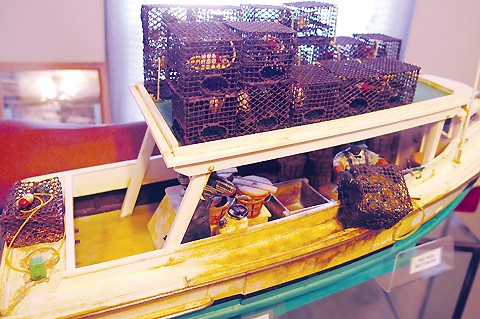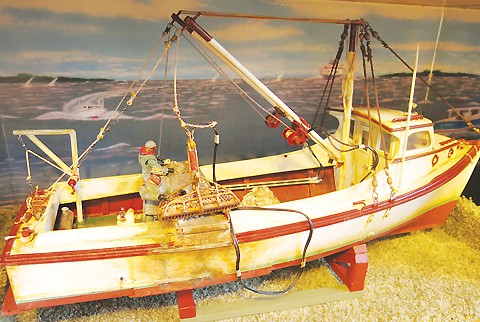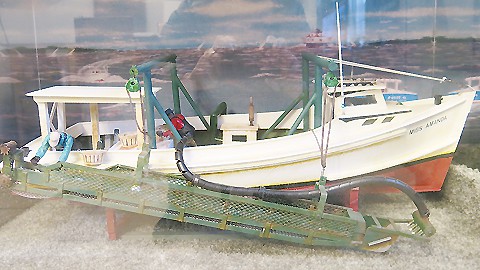Modeling Life on the Water
Watermen name their boats for their wives and girlfriends. There was a time when Norman Gross thought it a romantic gesture. Now, he’s not so sure.
“Why did the men name the boats after their wives? Was it because they loved them? Or was it because they say stuff on the boat they couldn’t say at home?” the 58-year-old Gross wonders.
The heir of generations of watermen, Gross has spent his life working on boats. When the weather is good, he is outside repairing. When days turn cold and wet, he makes models. Each one is a project unto itself, usually a model of one of the boats he has known. His boat models are life stories, and they typically include figures of his family.
Gross doesn’t use pictures to make the models, relying instead on his photographic memory and dedicated craftsmanship.
“It takes three weeks to build the boats. It takes another three weeks to a month to cut the figurines. I take my artist’s knife and cut all the guns and hand grenades off of action figures I buy at the store,” he says.
“I sit down and put clothes on ’em and dress ’em, put their hats on ’em and everything like that, and then I got to bend the mold to move, to hold the tongs, to position ’em. You will not find this in the hobby shop.”
Gross has no interest in putting a boat inside a bottle, as other people have done that. He does what no one else has done: capture the watermen, their families and their boats before all record of it goes away.
The History He Records
Frank Gross, his father, was one of the first black captains on the Chesapeake. His captain’s cap is proudly — and untouchably — displayed alongside the models.
Working the water was cold and hard, Capt. Gross told his family. Sister Debbie sassed him once, saying she didn’t think his life so hard. The next day, he took her oystering. She still remembers the cold and the slime of the oysters on the deck. You could go in the cabin to warm up, but then you had to go back out on deck. She never again told him his life was easy.
Sisters Marilynn (aka Bill) and Edna also gather around their brother, remembering how their father came home, wet and stiff from the cold.
“We had to turn his gloves over on the other side, cause they was all wet to dry ’em out,” Debbie said.
Gross was five years old when he first went out on the water. He could reach the oysters only by standing on an overturned basket. That day, Norman told his father this was not the life for him. He was not going to work on the water. Repairing boats, he doesn’t have to.
Building models came later in life. He built the first when he was 51. It turned out pretty well, but it was made of balsa wood, so it disintegrated in the water. After that, he worked on his technique. The models are sturdier now.
Displayed in glass cases in his back bedroom are eight models Gross has made of his family boats. There are early ones, boats that belonged to his father and grandfather, as well as later models.

The Miss Myrtle was his father’s boat, and on the boat are all the people, crabs and fish that belonged there: Capt. Gross and his wife, who sketched and taught her children, particularly Norman, to draw; all of the brothers and sisters, including Edna, always on the port side because that was her lucky spot. There she could drop her line in the water and catch the first fish of the day.
His favorite model is their uncle’s boat, Puddin, because it is worn. You can see the dirt on the side of the boat as a haul of oysters is pulled onto the deck.

Not all the models are working boats. There is one of Gross and his wife fishing on their Wellcraft, the Linda Mae; another of his uncle’s boats, Estelle — no gear or wear on that boat. Uncle Paul never took it out. Everybody laughs about that.

Another model is not of a boat but of Norman and his brother, Buck, and friend, Peewee, standing in clear water crabbing. The water is molded out of a piece of Plexiglass. Gross remembers the day in 1980 this model depicts.
“The water was this clear,” he says. “Back in the day, you used to go to the water with a crab net and you see the crab jump like into the bushes, and that’s how you get ’em. But you’re not gonna see that anymore.”

• • •
The water is not so clear now and the crabs are not so plentiful. Things have changed. Because the Chesapeake is changing and the life that he remembers will eventually go away, each winter Gross chooses another boat to build and which figures, tools and fish he will add. The models he builds are reminders of another way of life.

